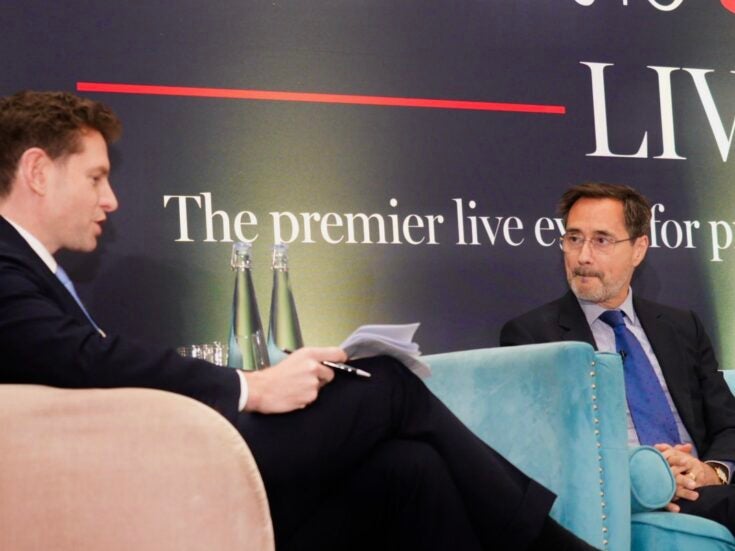
Peer-to-peer lending, or crowdlending, is proving a godsend for SMEs and investors alike. Christopher Silvester reports
How many of you remember those heady days when the Bank of England base rate was above 10 per cent? The last time this was the case was during the first half of 1992. For most of the Nineties the base rate was falling, then it edged upwards again to 5 per cent in 2003 before falling back in the autumn of 2008, when the global economic crisis arrived in full force. Since March 2009 it has remained steady at 0.5 per cent. As a result, bank depositors have been having a miserable time of it, while business borrowers too have suffered from a credit squeeze.
It has only been in the last few years that the ‘peer-to-peer’ (P2P) lending phenomenon, also known as crowdlending, arrived on the scene. Since then the loan books of online P2P lenders have been growing by an estimated 175 per cent per annum and these companies have emerged as strong competitors to the banks as a source of finance for small and medium-sized enterprises (SMEs). The P2P sector is expected to smash through the £30 billion barrier by 2025.
Crowdlending is not to be confused with crowdfunding. True, both sit in what is called the alternative finance space, or Alt Fi; but crowdfunding is mainly occupied with raising equity for start-ups, whereas crowdlending is geared towards established SMEs that are unable to obtain working capital other than by paying excessive fees to the high street banks. In general, P2P businesses are able to minimise investment risk to their investors by ensuring that each borrower is funded by numerous investors, whereby each risks a comparatively small amount.
However, each P2P lending platform has its own business model and its own unique approach to reducing risk still further. Spear’s has spoken with the leaders of three of them: MarketInvoice, the oldest, has done £600 million of business, Platform Black has done over £100 million, while ArchOver, launched eighteen months ago, has done just over £1 million, although it is currently the fastest-growing P2P lender outside the property sector.
Now barely in his thirties, MarketInvoice’s CEO Anil Stocker studied economics at Cambridge, where he met his co-founders, and was working in private equity when he began to appreciate how hard it was for SMEs to obtain finance from the banks. He wrote his business plan in 2011. ‘I didn’t know much about this asset class at all, so I was really looking at it with a fresh pair of eyes,’ he recalls, ‘and I didn’t realise that Fintech would become such a big movement.’
MarketInvoice has two types of investor. The passive investor puts money into an account and sets up their AutoBid tool, which allows them to build up a portfolio without having to bid manually. They set their criteria for allocating their money into the ten different risk bands and can also set limits for how much money they wish to have outstanding from a particular underlying small business. Then there are active investors, who do their own due diligence, take bigger exposures on certain trades, and spend more time directly building their portfolio.
‘Sixty per cent of our current funding base comes from high-net-worth and high-net-worth-plus,’ says Stocker. ‘It’s a particularly interesting investment class for them. Why? Because it’s short duration, a liquid product, with invoices typically taking 45 to 50 days to be paid. There are no lock-ups, no minimum fees, and the risk/return profile is very attractive. Technically, investors are not lending to businesses, they are buying an asset, a receivable, which is transferred to them by way of a true sale, so that in the event of a delinquency there is a much higher rate of collection because we can go to the end-customer as well as to the small business in the recovery process. Our recovery rates have been between 85 and 90 per cent — that’s much higher than other P2P platforms. Since inception we’ve delivered about 10 per cent net returns.
‘This is the first time that investors have been able to get into this asset class. Invoice finance receivables have always been factored through the banks, which make healthy margins on that activity, even though they have very high cost bases.’
When it comes to family offices, Stocker prefers those with a professional management team because they are more open to new ideas. They usually start with a relatively small amount, perhaps £100,000, and then scale up over time. ‘The great thing about our model is that you see exactly the return you’re making and the loss rate. You’re not waiting for five years to get your principal back and in the meantime just getting interest.’
MarketInvoice has done £650 million of business in more than 10,000 trades across its platform, ‘which is the most of any P2P in the UK, if not the world’. One of its satisfied investors is Oliver Jory, a former investment banker who was working for the Prince’s Trust as a voluntary specialist co-ordinator when he met with Stocker in the early days of MarketInvoice. Now a full-time investor based in Chicago, Jory is an enthusiast for the platform.
‘I rely predominantly on the AutoBid feature and limit my exposure to any one seller or debtor to about 3 per cent of my funds in the system,’ he says. ‘I usually avoid very short-duration invoices. I believe I am at the adventurous end of the investor spectrum as I tend to skew my portfolio towards higher-yielding trades. As a result I expect a higher number of problem loans which can sit unresolved in the system for months, but I have been impressed with MarketInvoice’s ability to get eventual recovery on many such positions.’
Jory particularly likes two aspects of the MarketInvoice model. ‘One is the “belts and braces” security of having both debtor and seller take responsibility for ultimate repayment; the other is the 40-day duration, which means an investor could expect to get back the majority of their funds within one to two months if required.’
Bidding for receivables on the internet might seem rather raffish to more conservative institutions or investors, but their fears would be misplaced, argues Jory: ‘Investing in invoices is complementary to holding a securities portfolio and its contractual income characteristics are particularly attractive at this time when valuations of traditional assets appear stretched.’
Caroline Langron, managing director of Platform Black, is a gamekeeper turned poacher, having looked after invoice risk and invoice trading in the SME sector for 35 years, ten of them at Close and ten at Barclays. ‘Where I come from you would have institutional funders,’ she says. ‘Here I have a whole tranche of family offices and HNWs funding my business, but the principle is the same — looking after somebody else’s money.’ Far from being hostile, she adds, the banks ‘don’t really see P2P lenders as disruptive any longer. I do a lot of combination deals with them, whereby they fund the majority of the debt and I help them out with the top slice. We talk the same language.
‘With invoice trading funders need to understand our products, which are of short duration and liquidity, between 30 and 90 days. We have to make the experience good for funders so they will want to use us as and when they have liquid funds. Our average return is about 0.8 per cent per 30 days, so it works well for property developers with surplus cash on their hands for a few months. That’s a net return. On an annual basis, that ramps up to 8 or 9 per cent. Family offices with experienced managers understand that return.’
In 2015 Platform Black did £30 million of trades. This year it has already booked in £50 million and it expects turnover of between £50 million and £80 million. It has 189 registered funders, of which 90 are currently exposed to trades, ranging from the smallest funder (£5,000) to one family office that has got an exposure of £600,000. ‘The majority of our funders are either family offices or HNWs. But if we go by funds in use, we’ve got two or three institutional funders that have large sums invested and therefore they represent the greater part of our business. We have three deals this month requiring lines between £1 million and £2.5 million. Clearly you can’t fill those opportunities from family offices, most of which will want to put somewhere between £50,000 and £500,000 on to our platform. We like to keep a mix of funders so that we can meet everyone’s requirements as best we can.’
ArchOver was founded by CEO Angus Dent, an accountant by training and a former CFO who had worked in the food and software businesses, and veteran City PR man Brian Basham, who is its executive chairman. It only lends to companies with strong balance sheets, only against accounts receivables (ARs), and only for periods between six months and two years. It will lend up to 80 per cent of the value of the ARs and once the loan is made the ARs must be maintained at 125 per cent of the value of the loan (which is monitored on a monthly basis). This provides a quickly realisable asset for investors in case the borrower gets into difficulties over repaying the loan.
‘We’re about price, process and planning,’ explains Dent. ‘We’re looking at invoices in a pool, which reduces the administrative burden for the borrower. The borrower doesn’t have to send us every invoice. That enables an SME to plan ahead, which is a huge benefit. What’s more, unlike a traditional invoice discounter we don’t interfere in the primary relationship between the borrower business and the borrower’s customer.’
ArchOver’s USP for is that it also uses credit insurance to provide security for both sides of a trade. The Hampden Group, which manages insurance assets and Lloyd’s underwriting capacity over £2 billion, is a shareholder in ArchOver as well as an active lender across the ArchOver platform. What’s more, ArchOver has teamed up with COFACE, a leading global credit insurer and an acknowledged expert in international trade risk, to create future protection of up to £100 million that will reduce the cost of credit insurance for the borrowing company significantly.
Since the insurance homogenises the risk, the only variation on the interest rate is time. The longer the loan, the higher the interest rate. Borrowers repay interest on a monthly basis with a capital repayment at the end of the term and ArchOver makes its money from the spread between the lender and borrower interest rates. Lenders are paid in monthly instalments, two days after the borrower repays.
ArchOver has roughly 400 registered funders, of which 50 are active, and 26 projects ranging from £100,000 to £1 million. As an example of an HNW funder Dent points to Schreiber Holdings, which looks after the investments of the Schreiber family, which sold its furniture brand to MFI in the 1980s. Schreiber has substantial long-term property investments but was looking to generate a predictable income stream from a medium-term investment. The company has found that ArchOver offers a higher return than any bank deposit account, and that it can get its investment back within two years or less.
‘Although our investment through ArchOver is just part of our overall investment portfolio,’ says Graham Morris, chairman of Schreiber Holdings, ‘it is a significant part and one that I am very positive about.’
Similarly, the governors of the Knightsbridge School, a London prep, were looking for a steady income return that outperformed bank deposits and avoided the volatility of the equity markets. ‘We liked ArchOver’s due diligence and its 6.5 per cent return, which is much better than we could get anywhere else,’ says William Russell, chairman of the school’s governors. ‘There is always a risk, even with a bank, but we took the view that the ArchOver platform was as safe an investment as most options.’
Relative safety, liquidity, and the lack of correlation with equity markets mean that for HNWs, family offices, private schools, and even charities with substantial reserves, it perhaps makes sense to have a P2P as part of a diversified portfolio.






